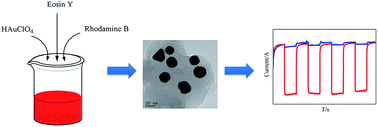A novel photoelectrode based on eosin Y–rhodamine B duo-dye sensitized Au nanoparticles by in situ reduction
Abstract
A novel and facile method for the fabrication of an indium tin oxide (ITO) photoelectrode modified with eosin Y–rhodamine B duo-dye sensitized Au nanoparticles is presented. After mixing with HAuCl4, a precipitate emerged in the duo-dye solution of eosin Y and rhodamine B. The precipitate was collected, dispersed in ethanol and spin-coated onto the ITO electrode. Different techniques were used to characterize the precipitate, including scanning electron microscopy (SEM), transmission electron microscopy (TEM), X-ray diffraction (XRD), X-ray photoelectron spectroscopy (XPS), ultraviolet-visible spectroscopy (UV-Vis), infrared spectroscopy (IR) and photoluminescence (PL). Results of the characterizations showed that HAuCl4 was reduced to Au nanoparticles in situ, which were transformed by rhodamine B, while eosin Y retained its original molecular structure, forming an eosin Y–rhodamine B–Au nanocomposite. Compared with a solution containing only HAuCl4 and rhodamine B, the solution containing all three components produced more eosin Y–rhodamine B–Au nanocomposite precipitate, and exhibited an appreciable photocurrent response in the photoelectrochemical system. Furthermore, the modified ITO photoelectrode gave a specific response in the presence of Hg2+, which offers potential in the fields of environmental monitoring and food safety.



 Please wait while we load your content...
Please wait while we load your content...